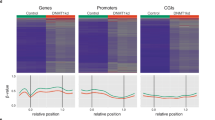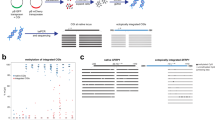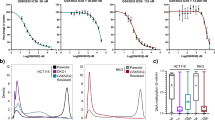Abstract
Silencing of hMLH1 expression by aberrant hMLH1 promoter methylation accounts for the majority of sporadic colon cancers with microsatellite instability. We have previously shown hMLH1 silencing is biallelic and actively maintained. To study the mechanism of aberrant hMLH1 methylation, we assayed whether an hMLH1 methylated cell could transfer methylation and silencing to an exogenous hMLH1 promoter in somatic cell hybrids between hMLH1 methylated-silenced and hMLH1 unmethylated-expressing colon cancer cells. Conversely, we assayed whether these hybrids could reactivate expression of initially methylated and silenced hMLH1 alleles. Compellingly, within the hybrids each hMLH1 allele remained unchanged, retaining the expression status of its parental cell of origin. This chromosomal autonomy may not be simply determined by DNA methylation, as it is reasserted after experimentally forced demethylation of all hMLH1 alleles in the hybrids. Confirming findings included hMLH1 methylated cells being unable to methylate single transferred exogenous hMLH1 expressing chromosomes or transfected hMLH1 reporter constructs. hMLH1 silencing does not conform to either a dominant or recessive model, and is not determined by trans-acting factors differing between hMLH1 expressing or silenced genomes. We posit that hMLH1 methylation is dependent on and maintained by cis chromosomal marks, whose nature remains to be elucidated.
This is a preview of subscription content, access via your institution
Access options
Subscribe to this journal
Receive 50 print issues and online access
$259.00 per year
only $5.18 per issue
Buy this article
- Purchase on Springer Link
- Instant access to full article PDF
Prices may be subject to local taxes which are calculated during checkout




Similar content being viewed by others
References
Arad U . 1998 Biotechniques 24: 760–762
Baylin SB, Herman JG, Graff JR, Vertino PM, Issa JP . 1998 Adv. Cancer Res. 72: 141–196
Casey G, Plummer S, Hoeltge G, Scanlon D, Fasching C, Standbridge EJ . 1993 Hum. Mol. Genet. 2: 1921–1927
Cheng Y, Poulos NE, Lung ML, Hampton G, Ou B, Lerman MI, Standbridge EJ . 1998 Proc. Natl. Acad. Sci. USA 95: 3042–3047
Deng G, Chen A, Hong J, Chae HS, Kim YS . 1999 Cancer Res. 59: 2029–2033
Eshleman JR, Markowitz SD . 1996 Hum. Mol. Genet. 5: 1489–1494
Geiser AG, Anderson MJ, Stanbridge EJ . 1989 Cancer Res. 49: 1572–1577
Grady WM, Rajput A, Lutterbaugh JD, Markowitz SD . 2001 Cancer Res. 61: 900–902
Grady WM, Willis J, Guilford PJ, Dunbier AK, Toro TT, Lynch H, Wiesner G, Ferguson K, Eng C, Park JG, Kim SJ, Markowitz S . 2000 Nat. Genet. 26: 16–17
Hark AT, Schoenherr CJ, Katz DJ, Ingram RS, Levorse JM, Tilghman SM . 2000 Nature 405: 486–489
Herman JG, Umar A, Polyak K, Graff JR, Ahuja N, Issa JP, Markowitz S, Willson JK, Hamilton SR, Kinzler KW, Kane MF, Kolodner RD, Vogelstein B, Kunkel TA, Baylin SB . 1998 Proc. Natl. Acad. Sci. USA 95: 6870–6875
Hsieh CL . 2000 Curr. Opin. Genet. Dev. 10: 224–228
Issa J . 2000 Ann. NY. Acad. Sci. 910: 140–153 discussion 153–155
Ito E, Yanagisawa Y, Iwahashi Y, Suzuki Y, Nagasaki H, Akiyama Y, Sugano S, Yuasa Y, Maruyama K . 1999 Biochem. Biophys. Res. Comm. 256: 488–494
Jacobsen SE, Meyerowitz EM . 1997 Science 277: 1100–1103
Jeddeloh JA, Stokes TL, Richards EJ . 1999 Nat. Genet. 22: 94–97
Kane MF, Loda M, Gaida GM, Lipman J, Mishra R, Goldman H, Jessup JM, Kolodner R . 1997 Cancer Res. 57: 808–811
Kuismanen SA, Holmberg MT, Salovaara R, de la Chapelle A, Peltomaki P . 2000 Am. J. Pathol. 156: 1773–1779
Kuzmin I, Geil L, Ge H, Bengtsson U, Duh FM, Stanbridge EJ, Lerman MI . 1999 Oncogene 18: 5672–5679
Lee YW, Klein CB, Kargacin B, Salnikow K, Kitahara J, Dowjat K, Zhitkovich A, Christie NT, Costa M . 1995 Mol. Cell. Biol. 15: 2547–2557
Markowitz S, Wang J, Myeroff L, Parsons R, Sun L, Lutterbaugh J, Fan RS, Zborowska E, Kinzler KW, Vogelstein B . et al 1995 Science 268: 1336–1338
Papadopoulos N, Nicolaides NC, Wei YF, Ruben SM, Carter KC, Rosen CA, Haseltine WA, Fleischmann RD, Fraser CM, Adams MD . et al 1994 Science 263: 1625–1629
Robertson KD, Junes PA . 2000 Carcinogenesis 21: 461–467
Veigl ML, Kasturi L, Olechnowicz J, Ma AH, Lutterbaugh JD, Periyasamy S, Li GM, Drummond J, Modrich PL, Sedwick WD, Markowitz SD . 1998 Proc. Natl. Acad. Sci. USA 95: 8698–8702
Wiesner GL, Platzer P, Buxbaum S, Lewis S, MacMillen M, Olechnowicz J, Willis J, Chakravarti A, Elston RC, Markowitz SD . 2001 J. Natl. Cancer Inst. 93: 635–639
Willson JK, Bittner GN, Oberley TD, Meisner LF, Weese JL . 1987 Cancer Res. 47: 2704–2713
Acknowledgements
We thank Song Song for her technical assistance. The work is supported by PHS grants RO1 CA67409, RO1 CA72160 and P30 CA43703, and by gifts from the National Colon Cancer Research Alliance. S Markowitz is an associate investigator of the Howard Hughes Medical Institute.
Author information
Authors and Affiliations
Corresponding author
Rights and permissions
About this article
Cite this article
Li, H., Myeroff, L., Kasturi, L. et al. Chromosomal autonomy of hMLH1 methylation in colon cancer. Oncogene 21, 1443–1449 (2002). https://doi.org/10.1038/sj.onc.1205247
Received:
Revised:
Accepted:
Published:
Issue Date:
DOI: https://doi.org/10.1038/sj.onc.1205247
Keywords
This article is cited by
-
CpG island methylation is a common finding in colorectal cancer cell lines
British Journal of Cancer (2003)



